Many babes in modern world practically not familiar with mother's milk. Unfortunately, this is not good, because all pediatricians and neonatologists know very well how important breastfeeding is for a baby. The fact is that mother's milk, in fact, protects the newborn from the harmful effects of external factors, since the immunity of the child is very weak. Breast nutrition is very important for the first 6 months of life, because artificial feeding of a newborn will not provide high-quality protection and, conversely, can lead to abnormal development and initiation of pathological processes in certain cases.
Indications and causes of artificial feeding
The indications include, first of all, the absence of breast milk.
Many mothers who feed with artificial mixtures are well aware of what is agalactia. This diagnosis means the complete absence of breast milk. Unfortunately, this phenomenon is not uncommon.
In addition to agalactia, indications for artificial feeding can be:
- Reception of some drugs mother;
- Infection in the mother;
- Severe pregnancy and childbirth;
- Mental disorders of the mother;
- Metabolic disorders in the newborn.
It is also worth pointing out the main reasons because of which the mother consciously switches to artificial feeding of the baby herself:
- social conditions, for example, access to work;
- lack of weight gain in the baby;
- lack of milk;
- child's reluctance to eat breast milk;
- mother’s individual unwillingness to breastfeed a baby.
Here are the main factors contributing to the feeding of the child with artificial mixtures. And the latter are very subjective.
Types of mixtures
All mixes intended for newborns are divided into dry and liquid. The advantages of dry mixes are that they are stored longer and, most importantly, much cheaper than liquid ones. However, the latter do not need to be cooked, for the mother there is no need to count the proportions, which means there is no risk of being wrong.
Mixtures are also divided into casein and whey substitutes. The fact is that breast milk is rich in proteins, which are provided in the form of caseins and whey proteins. Therefore, it is extremely important when choosing to give preference to more dear mixtureswhere the ratio of these components is correct and verified.
The formula for feeding on the composition should be as close to breast milk
More mixtures can be divided into special and standard. The first intended for premature babies, as well as for those who suffer from allergies and problems associated with metabolism. Basically they are made on the basis of soy. They are prescribed only by pediatricians, observing this or that child. Standard mixes are suitable for all babies, without any violations. They are made on the basis of cow's milk.
There are adapted and partially adapted mixtures. The first are suitable for newborns, as the composition is as close as possible to breast milk. The second can be given to older children, because the composition is approximately similar to mother's milk.
Which mixture to choose
All mixtures are similar to each other. Going to the store for an artificial mixture, the newly-minted parents may be at first great confused, because they will have to choose a product from thousands of different mixtures presented on the shelves of supermarkets.
However, if you read the content of cereals, you can quickly come to the conclusion that they are all made on the basis of some ingredients.
The only difference is DHA fatty acid, which is used by only a few manufacturers. Scientists have recently proved that this component has a very positive effect on the development of a newborn, therefore, being among commodity abundance, you just have to read the compositions of the mixtures, and you will surely find the desired product.
Contraindications
Milk allergy. The vast majority of children calmly endure artificial nutritionhowever, some children may experience allergies, indicating individual lactose intolerance.
If you see that your child is covered with a small rash, take a look at his diaper. Allergies will indicate feces with blood and mucus. In this case, you should immediately contact the doctor, who will appoint a specialized soy-based mixture to the baby.
The child’s need for a mixture. An interesting feature is that all children use a different amount of the mixture per day. It is officially considered that the portion of porridge for the baby should be 120 ml per kilogram. However, the calorie content of the mix is important. Therefore, if the fat porridge is insufficient, then you should not be surprised that the child cries from hunger all the time, even if you follow all the recommendations of the pediatrician.
Children who eat artificial mixtures are less likely to eat. The fact is that breast milk is absorbed by the body much faster and, accordingly, such a child is more likely to feel hunger than an artificialist. However, you should not hope that after the transition to artificial nutrition you will have less worries, because all children are individual, and it will be difficult to predict something with a 100% probability.
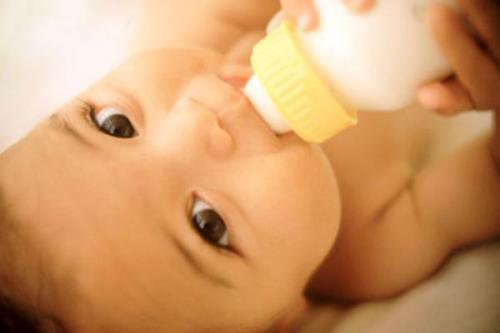
Artificial feeding baby should be about 120 ml of the mixture per day
Changes in the baby's chair. In children who eat artificial mixtures, the stool is thicker, darker and with a more pungent odor than in baby. This is explained by the fact that the composition of the mixtures still does not completely imitate mother's milk.
Preparation of the mixture
All packages with dry powder have detailed cooking instructions. It indicates how much powder needs to be poured on a certain amount of water. It is advisable to fully adhere to this instruction, because improper feeding can lead either to excessive weight gain and constant regurgitation, or to underweight and whims.
To prepare the mixture, you must first boil water. Then it should be cooled slightly and poured into the bottle. Next, you need to pour a certain amount of powder specified in the instructions and mix well. The ideal temperature of the mixture is 36 °.
Then you need to check the resulting mixture for temperature again, causing a drop on your wrist. If you practically do not feel it, that is, the mixture has cooled to room temperature - you can safely feed the child. However, it is worth remembering that food residues should never be given to the child again.. If the baby has not eaten the mixture, discard the rest and make a new one next time.
Video about the features of artificial feeding:
Feeding with artificial feeding
The introduction of complementary foods should begin at the age of about 4.5 months. Before the start of this process, it is worth consulting with the pediatrician who is observing your baby. With breastfeeding complementary food is introduced at a later age - about six months. How is this procedure performed?
You can start from fruits or vegetables that must be whipped to a puree. The first time the child should be given a portion of not more than half a teaspoon. Then gradually increase. Thus, for 2 weeks the portion should be brought to a single volume of the mixture.
It is categorically impossible to use as a lure 2-3 product, it is fraught with impaired work in the digestive tract of the baby.
What you need to know about artificial feeding
- Carefully control the amount of mixture eaten;
- Be sure to sterilize the nipple and bottle before feeding;
- Correctly pick up the nipple for the child, the form should be comfortable;
- Try several mixes first and choose the most suitable option;
- When cooking, follow the instructions exactly;
- In time and carefully begin to perform the procedure of feeding.
Undoubtedly, nothing can replace breast milk, but, nevertheless, the mixtures serve him as an excellent alternative. There are many analogues on the market, but it is very important to choose the most optimal powder for a child. Properly chosen mixture will not only replace milk well, but also have a beneficial effect on the child's weight gain.
Not all women are able to breastfeed to feed their children, who have just been born. And if in former times it became a big problem, and there was a question of whether the child would survive or not, nowadays another one is already relevant: “How to set up bottle feeding newborn, so that it brought him maximum benefit? "
To great happiness, at the moment there is a wide variety of which are adapted and as similar in composition as possible to the breast milk of the mother. In order for the newborn to pass without problems, you need to choose the right food for the baby.
So, to choose you must consider the following:
1. How old is your baby? The fact is that there are mixtures for different periods of a baby’s life: from 0 to 6 months, from 6 months to a year, from a year to one and a half years. Accordingly, the numbers on them are 1, 2, 3. Always change the mixture to the next as the child grows up.
2. Adaptation. Remember, in order to establish artificial feeding of the newborn, it is necessary that the infant formula be only adapted. Unadapted food can cause significant harm to the little man.
3. Individuality. Do not forget that what is suitable for one child may not be suitable for another. Therefore, pay attention to the fact that the mixture is chosen based on the individual characteristics of the organism. If the baby has symptoms of food intolerance, it should be removed and replaced with another.
4. Mandatory consultation with a pediatrician. If your baby suffers from allergies or persistent regurgitation, he may be prescribed a hypoallergenic or antireflux mixture. Fermented milk mixtures are used to normalize the work of the intestine. Therapeutic mixtures can be applied for a short period of time, then it is worth returning to normal nutrition again. 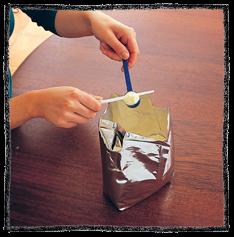
Diet
If, when feeding a baby, the mother gives him a breast on demand and at the slightest squeak, then artificial provides for meals for hours. Just a day, the child should receive the mixture 6-7 times, and feeding should occur every 3-5 hours with a break for the night. Over time, the child is transferred to 5 meals a day. Neither juice nor water should replace feeding!
Artificial feeding of newborns: the norm
For a newly born child up to 2 months, consumption of the mixture is considered to be the norm, which amounts to 1/5 of the baby’s weight, from 4 to 6 months - 1/7, after 6 months - 1 / 8-1 / 9 of his body weight. 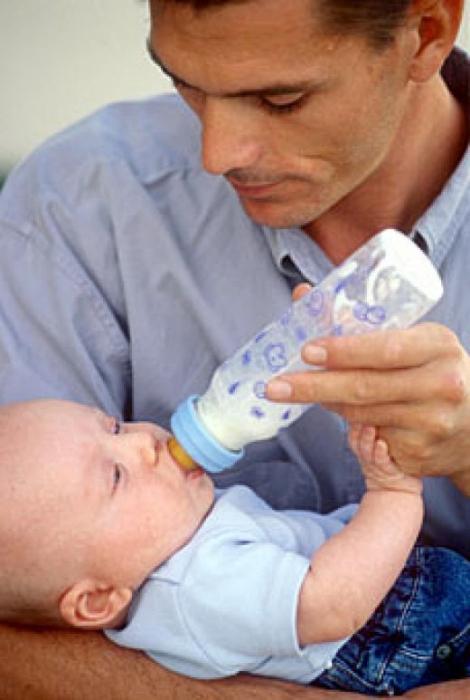
So which mix is still better? Let us turn to the advice of moms who provided excellent artificial feeding of the newborn. Their testimonies testify that the mixes "Nan", "Nutrilon", "Baby" French, "Frisot", "Similac" perfectly replace babies milk for babies, which means it is safe and even healthy to feed the baby with such nutrition!
Pick the right mix and grow a healthy baby!
The reasons for feeding with a bottle of the mixture are very respectful. Maybe you are restoring your professional activities, or you are sick, or because of the workload of the household, you do not have enough milk. It has been established that mixed and artificial feeding of a child affects growth, health, and development no worse than when breastfeeding. But despite all this, preference is still given to breastfeeding, remember this. To feed a child means much more than just providing him with satiety and the right substances.
Artificial and mixed feeding
Mixed feeding - feeding the infant formula from ¼ to ¾ of the total nutritional value of breast milk.
Artificial feeding of newborns implies that the mother’s milk in the infant’s diet is completely absent or is not less than ¼ of the total volume, and breast-milk substitutes form the basis of the nutrition. Breast milk substitutes are products of liquid consistency of animal (cow, goat) or, less commonly, of vegetable (soy) origin.
Do I need water except the main power? The answer is definitely yes. The mixture creates a load on the kidneys of the baby.
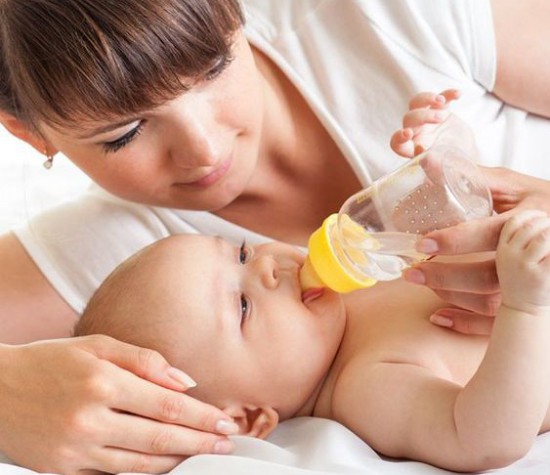
Types of dairy food
Dairy food can be adapted and unadapted:
- Unadapted dairy food is cow's milk, goats, or their fermentation products. Children up to 9 months can be given only in exceptional cases, as milk of animal origin is unsuitable for babies in their chemical composition. It contains too much protein and minerals, and too little unsaturated fatty acids. Currently, many pediatricians believe that whole milk should be completely excluded from the diet of children under 1 year of age - the risk of allergic reactions is too high, especially if you or your close relatives have an allergy.
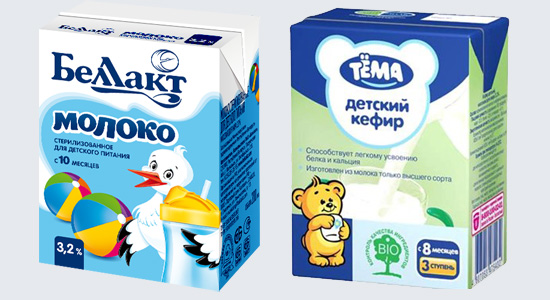
- Adapted milk formulas are as close as possible to breast milk, are easily digested, and can be used for a long time. But the position that mother's milk is the most valuable feeding product remains fundamental. Adapted mixtures are made from animal and vegetable milk.
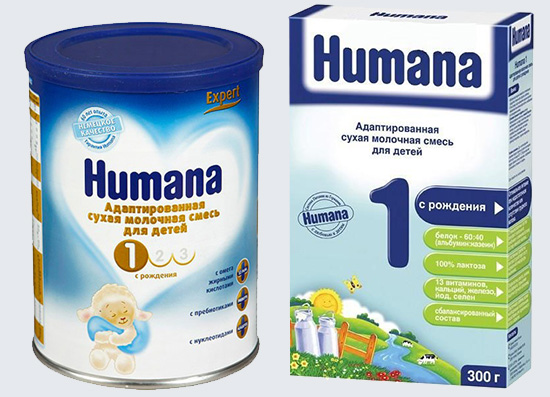
Primary and secondary nutrition:
- Primary nutrition is suitable for children from birth and is divided into:
- pre-primary nutrition - carbohydrates are represented by milk sugar (lactose) as in breast milk of a woman;
- products with the number 1 - in addition to lactose contain more starch.
- Secondary (subsequent) artificial mixtures marked with the number 2 - are an alternative for whole cow milk, which is not recommended in the first year of life.
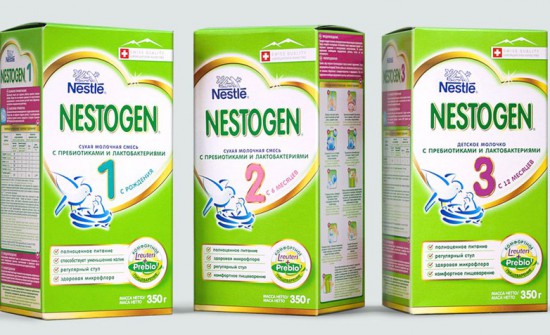
Prebiotics, probiotics
Especially valuable among breast milk substitutes are adapted milk formulas with pre- and probiotic properties.
Prebiotics - These are special nutrients consisting of a combination of galacto-oligosaccharides and fructo-oligosaccharides, which create a favorable environment for engraftment of the most optimal microflora in the intestine. They enrich dairy mixes and complementary foods.
Probiotics - living microorganisms with special properties, which are used in two directions: as starters for the production of fermented milk products and for enriching mixtures with probiotics themselves.
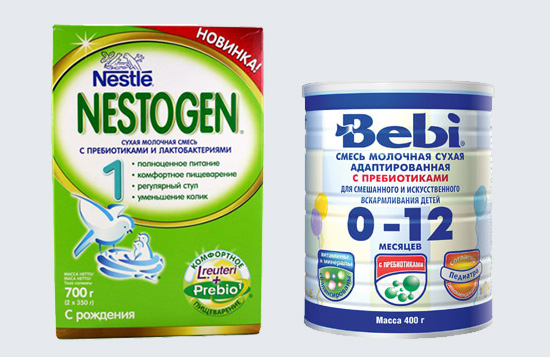
How to choose a mixture
The choice of the mixture should be carried out only by a pediatrician or another specialist trained in infant nutrition with mandatory dynamic control of the tolerance of the product.
Parents who prefer feeding with the mixture should be informed about the features of the selected breast milk substitute and possible health reactions to it.
You need to choose a mixture for a particular child, taking into account the following factors:
- baby age;
- adaptedness of the mixture - the younger the child, the more the composition of the mixture should be closer to the composition of breast milk;
- personal intolerance to the mixture of the child;
- material capacity of the family.
Artificial feeding rules
- Up to 5-6 months of life, artificial feeding of the baby is carried out with the most adapted milk formula.
- You can not use the feeding "follow" mixture, kefir or other non-adapted dairy food, whole cow milk.
- Stick to one kind of mix. If you find a product that tolerates your child well, then stick with this choice. Because the transition to another mixture creates a load on the digestive system of the baby and can cause bloating of the tummy.

Propensity to allergies
There have been quite a few studies proving that if mom or dad or the next of kin has an allergy, then the baby from such a family has a very high probability of developing allergies. And it happens, as a rule, in early age from 0 to 3 years. In this regard, such children are at risk for which it is difficult to overestimate the prevention of allergies. Ideal preventive measures are breastfeeding, subject to the mother's hypoallergenic diet.
If there are valid reasons for the inability to breastfeed, in this case, the mixture is injected only hypoallergenic.
Whole milk of animal origin, from which the adapted mixture is made, is not suitable for children from the risk group, and is completely excluded from the diet until one year of age.
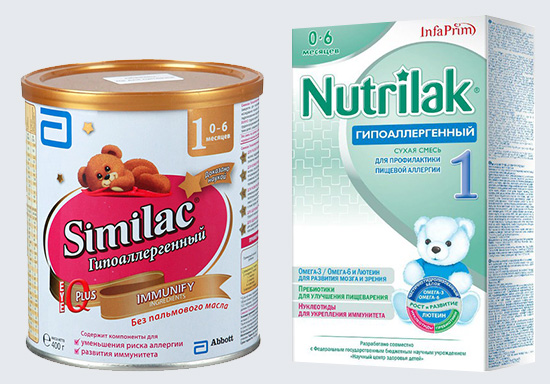
Special food
Specialized baby food is prescribed exclusively by a pediatrician for the treatment of a particular disease after a thorough examination of the child. These include:
- Nutrition for premature and low birth weight infants.
- Nutrition in case of identified allergy to animal protein:
- whey protein hydrolyzate;
- casein hydrolyzate.
- Nutrition for lactase deficiency:
- nutrition with reduced lactose (low lactose);
- lactose free, based on whey proteins;
- lactose free, protein hydrolyzate.
- Medical nutrition in functional disorders of the digestive system.
- Medical nutrition for the disease phenylketonuria.
- Therapeutic nutrition in regurgitation is antireflux.
- Medical nutrition for constipation.
- Medical nutrition for cystic fibrosis disease.
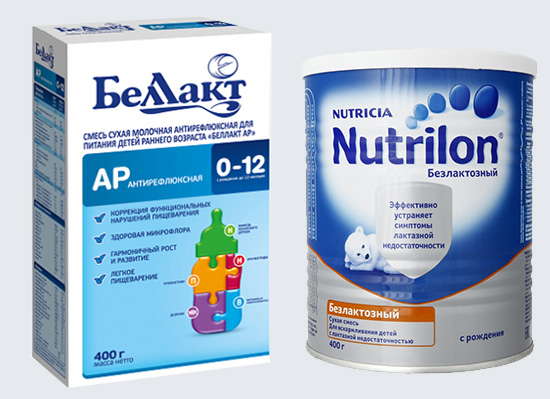
Bottles and nipples
Bottles are available in a choice of heat resistant glass or plastic.
- The pros and cons are obvious, for example, in terms of safety and convenience, more plastic are suitable.
- However, glass bottles do not contain harmful substances in the composition of the material from which they are made.
The volume of the bottles is different, they are acquired depending on the need for the amount of ml of food for your child.
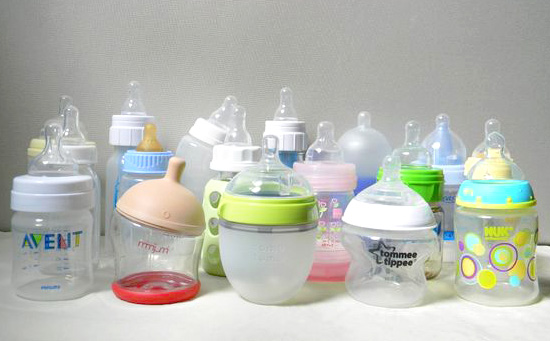
Nipples for bottles are also offered in two materials - brown latex (natural rubber) and silicone.
- Latex teats need to be changed more often, as they wear out faster, become sticky, and in some models allergy-causing substances have been found.
- Silicone is harder, almost non-aging and only requires cleaning. Forms manufacturers offer a wide variety.
The most important is the size of the hole, as it determines the flow rate of the fluid. It is important that the fluid be delivered at such a rate that the baby is satisfied with the sucking reflex, has had time to get enough and does not choke with too fast a stream.
Cleanliness
In the first months, hygiene is very important, as newborn babies are not yet protected from bacteria. The kitchen is better to equip a separate area for the preparation of food. Keep bottles and nipples better in a separate section. Use brushes and cleaning sponges exclusively for baby accessories!
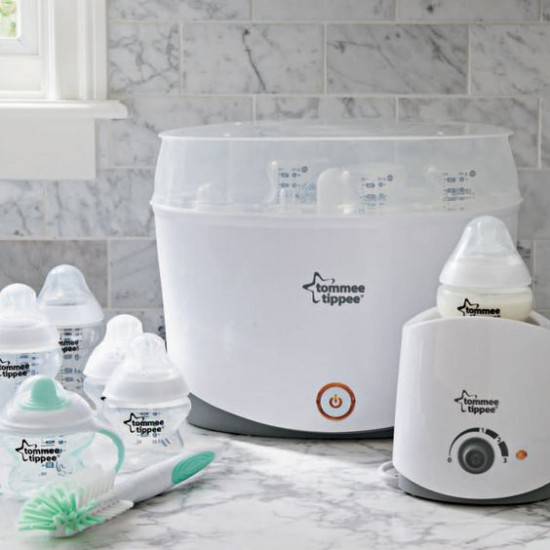
Bottle and Nipple Cleaning
Bottles must be carefully washed with a special detergent, and in hard-to-reach places they are cleaned with a special brush. For nipples, there are also special brushes.
If they are very dirty and do not wash off, you can clean them like this: sprinkle a pinch of salt and by wiping off the remnants of the product can be easily removed.
After cleaning, rinse thoroughly with running water to wash out the remaining detergent.
In the first six months, the bottles and nipples must be sterilized with a sterilizer or boiled in water for at least 5 minutes.
Later enough washing detergent and pouring boiling water.
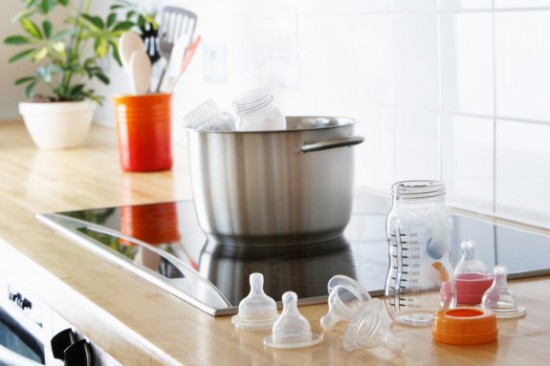
How to cook food
Each package has a detailed step-by-step instruction about the preparation of the product with the tables on the calculation of the amount depending on the age and weight of the baby. Strictly follow the rules of strict necessity.
- Be sure to wash your hands thoroughly before cooking with soap and warm water.
- For cooking food suitable only boiled water.
- It is necessary to use a special measuring spoon, measure the product without a slide, removing it with the back of a knife.
- Feeding should be freshly prepared. You can store it for 2 hours at room temperature and for 12 hours in the refrigerator. Heating in a microwave oven is often uneven, so you need to shake the bottle and check the temperature of the mixture, dripping on your hand. The remains of the mixture always pour out! Feeding the remaining heated mixture is unacceptable.
- Shake the bottle better by turning it on its own axis, or with a sterile spoon with a long handle. So you do not run air bubbles that can cause bloating.
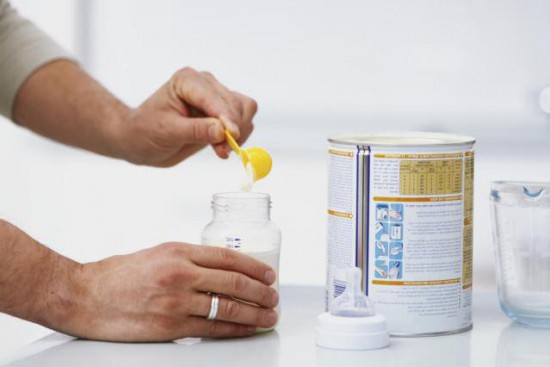
Cooking water
Water should always be fresh and boiled 1 time, cooled to 40 degrees, re-boiled water is not suitable.
In stores in the departments of baby food there is mineral water for children, it is best to use it.
You can use the tap water, but always passed through a water purification filter, after having been discharged from the tap for 1-2 minutes. Watch for the expiration date of the filter, you need to change it in a timely manner.
Bottle feeding ritual
As it was said at the beginning, the child needs not only to be fed with food, he also feels your intimacy, warmth, which create the feeling of security that is so necessary for him. The feeding process builds the foundation of the relationship between the baby and the mother, causing particular quivering feelings. Allocate time for feeding and take your time, your presence is important for your child, it is provided by nature.
Zaitseva Valentina,
Doctor, General Medicine